Orbiting about 250 miles (400-ish km) above our heads is one of the most complex and expensive engineering projects that the human race has ever put together: the International Space Station (ISS). The station masses around 450 tons (400 metric tons) and is a bit larger than an American football field. Its assembly required dozens and dozens of launches by Russia and the US (including 37 space shuttle flights), and it took astronauts and cosmonauts 155 spacewalks to get the whole thing bolted together—2.5 times more spacewalks than had previously occurred since the beginning of space flight.

Enlarge / The International Space Station compared to the size of an American football field.
NASA
The ISS has taken 13 years and as much as $150 billion to build and fly; to call it valuable real estate is an understatement. As we Americans are relaxing for the Fourth of July and drinking beers or lighting off fireworks, high above our heads, six human beings are working in space. But the station isn't just sitting up there, static and unmoving. The ISS' orbit decays due to atmospheric drag at the rate of about two kilometers per year; it must periodically be boosted in order to maintain its height. Moreover, the entire massive structure is mobile—it can be rolled and pitched and yawed, or even moved ("translated," in NASA parlance) in three dimensions to avoid a potential collision with debris.
 The International Space Station Flight Control Room on the second floor of Building 30 at the Johnson Space Center.
The International Space Station Flight Control Room on the second floor of Building 30 at the Johnson Space Center.
Ars Senior Science Editor John Timmer wrote back in May about the complex process behind moving unmanned satellites around in orbit —specifically, what it took to move NASA's Fermi Gamma-ray Space Telescope out of the way of some debris in its orbital path. But the ISS isn't an unmanned satellite; its mass is much larger. More importantly, it has six living, breathing human beings on board. How does one move 400 tons of fragile space station when there's an asteroid or something bearing down on it?
Ground control to Major Tom
To find out how to throttle-jockey the ISS around in orbit, I took a drive over to NASA's Johnson Space Center and met up with Josh Parris, a NASA ISS flight controller. Parris is one of the people tasked with manning a console in the ISS flight control room—or "Mission Control" as it's more commonly known. His station name is TOPO—Trajectory Operations Officer. As has been the case since the earliest days of manned space flight, the ISS flight controllers are all highly skilled individuals; Parris and his coworkers have all undergone years of specialized training to reach the point where they are trusted with "sitting a console."
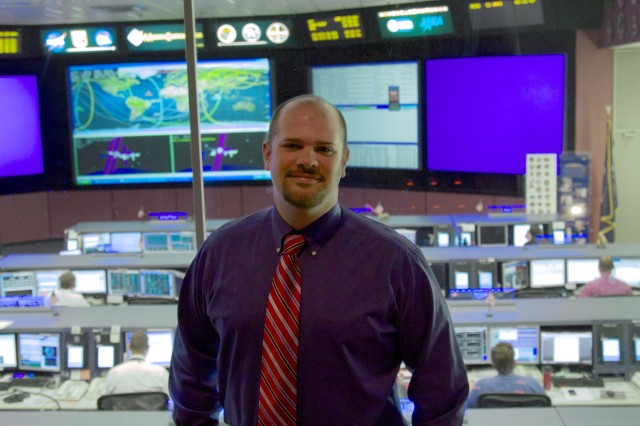
Josh Parris, ISS Flight Controller.
"TOPO is in charge of maintaining the knowledge of where the space station and visiting vehicles are, where they're going to be, and to make sure they don't get hit by anything," he explained. There aren't a lot of operational satellites at the ISS' normal flying altitude of about 400 km, but there is a fair amount of debris circling the earth at about the same height. There have been hundreds of potential "conjunctions" in the last couple of years—that is, warnings by ground-based radar sources about potential collisions between the station and some debris. In 2013 alone, there have been 67 potential conjunction notifications.
"What exactly makes up the debris?" I asked Parris. "Is it from the Chinese blowing up satellites?" "That's a big chunk of it," he confirmed. "Also, the collision between the old Russian Kosmos satellite and the Iridium satellite is a source of a lot of the debris we see. And that's just the stuff that's made it down to our orbit; there's plenty of debris still above us, just waiting to come down."
"Who tracks these things?" I asked. "Is there a big computer map like you see in the movies with fancy graphs and stuff?"
"USSTRATCOM, at Vandenberg Air Force Base," he replied. "They maintain a catalog of all pieces of debris—all objects in space—and routinely, three times a day, they screen the ISS trajectory versus that catalog. They're the ones who notify us if there's a close approach."
A "close approach"? That sounds scary. I asked Parris to elaborate, and he explained that there is an imaginary "pizza box"-shaped perimeter around the International Space Station. This perimeter extends two kilometers above and below the station and 25 kilometers "cross-track" and "down-track" (track here refers to the orbital path the station traces). If a piece of debris is expected to come anywhere within that box, USSTRATCOM notifies NASA.
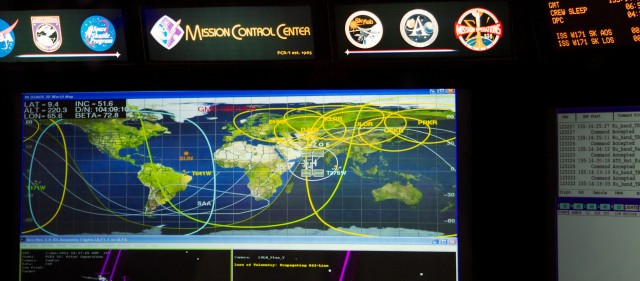
The main display at the front of the FCR, showing the station's position, orbital path, and the various ground stations with which it can communicate.
The TOPO controller keeps track of everything inside that pizza box-shaped perimeter, and they compute the probability of collision for all of the objects that they're tracking. TOPO assigns cautionary thresholds to each object depending on how likely a collision is. Any object with between a 1-in-10,000 and 1-in-100,000 chance of colliding with the station meets the "yellow" threshold. Flight rules say that the station must be moved out of the way in response to a yellow threshold object unless such a move results in a mission impact—"Like, if we do the burn, we're going to miss an opportunity to launch a Soyuz, for instance," explains Parris. "Do we delay the Soyuz, or do we do the maneuver?" A "red" threshold is assigned to any collision with a likelihood of between 1 (in other words, absolutely certain) and 1-in-10,000. Flight rules are more strict for maneuvers in response to red threshold objects: the station is always moved for a red threshold object, regardless of mission impact, unless a maneuver represents more risk than not maneuvering (for example, if there's a piece of equipment that's damaged on the ISS and a maneuver would exacerbate that damage).
Thrusters and gyroscopes
The ISS, for all its size and apparent fragility, is actually pretty agile. It has four gyroscopes, calledControl Momentum Gyros, or CMGs, which allow it to change its attitude. These gyros fall under the responsibility of the ADCO (Attitude Determination and Control Officer) flight controller, with whom TOPO often works when figuring out how to handle incoming debris.
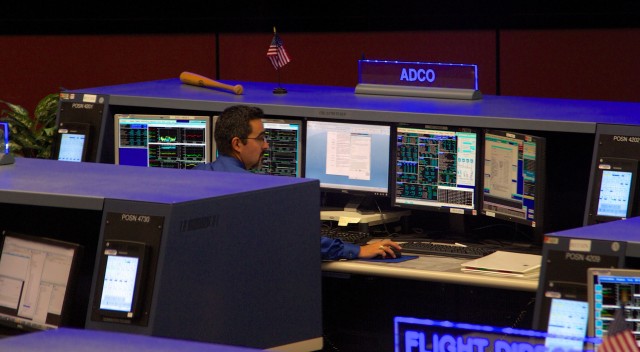
ADCO: the Attitude Determination and Control officer. Notice the baseball bat, for attitude adjustment.
Additionally, the station has several sets of thrusters that allow it to rotate and translate. The Zvezdaservice module is equipped with thrusters, and there are thrusters on docked vehicles like the Progress resupply craft and the ESA ATV that can also be employed. Space shuttles could also be used when they were still operational. For a typical debris avoidance maneuver, the station will be subjected to delta V of between 0.5 and 1 meter per second.
One of the parameters TOPO keeps track of is the station's mass, since the precise amount of thrust required to generate the required delta V varies depending on the mass that must be moved. The ISS' mass varies primarily when vehicles dock and undock. The level of delta V generated during a typical avoidance maneuver isn't enough to disrupt the routine of the crew—they're aware of when the maneuvers are happening, but it's all controlled from the ground and they don't have to do anything special. "They're not up there with joysticks zooming the station around, are they?" I asked. "No," laughed Parris. "It's all commanded from the ground."
Swinging into action
When a piece of debris meets the yellow or red thresholds, it becomes time to take action. At 28.5 hours before the chunk of debris' closest approach to the station, TOPO kicks off the debris avoidance maneuver planning process. "Why 28.5 hours?" I asked. It seemed like an odd number. "The Russian segment is the one who's going to be doing the burn," explained Parris. "Due to the time change between Houston and Moscow, that will allow enough time for their specialists to come in and design—well, they call it a 'cyclogram,' which is the program that is uplinked to the station that commands the vehicle to do the burn. That also allows us more time to get more tracking on the debris."
TOPO works with his Russian ballistic counterparts to determine the parameters of the avoidance maneuver, including how much delta V should be applied to the station. TOPO also coordinates back with USSTRATCOM to ensure that the maneuver they're planning will get them out of the way of the thing they're trying to avoid without inadvertently pushing the ISS into the path of some other chunk of debris. When the actual maneuvers occur, they are controlled by the ISS' onboard computers and monitored from the ground. There isn't really a way to grab a steering wheel and manually maneuver the ISS; everything is done as a result of careful planning, and the firing of the ISS' and docked vehicles' thrusters are always done through automation and strictly to plan.
The worst case
If the complexity surrounding debris avoidance seems excessive, it's important to remember that lives are at stake. "If we get hit by a tracked object, it could be loss of vehicle," said Parris. "They're moving at such great velocity, any impact of a tracked piece of debris could be catastrophic." The threshold for a tracked piece of debris is any object measuring more than about 10 cm. "Loss of vehicle" is exactly what it sounds like; a sufficiently energetic debris strike could not only destroy the station but cause the crew to perish as well.
Fortunately, Parris characterizes our knowledge of 10 cm-and-larger pieces of debris in the ISS' orbital height as comprehensive. "And the station has shields to protect against micrometeorites and stuff like that," he elaborates. "But there is a gap between the size the shields can deflect and the size we can track. There is a hole there, but we try to mitigate that as best we can with help from the Air Force."
Without trying to get too gloomy, I asked Parris what the "worst case scenario" would be if NASA found the ISS facing an unexpected conjunction. The people at USSTRATCOM almost always give NASA a three-day warning on potential conjunctions, but very rarely things are missed. "We can typically always find a clear path for something we know about," explained Parris. But if a conjunction is spotted and NASA doesn't have the 28.5 hour-window to jointly plan an avoidance maneuver with Russia, they have a contingency to fall back on called a PDAM—a Predetermined Debris Avoidance Maneuver. The PDAM is a 0.5 meter-per-second "canned" maneuver that can be executed very quickly to push the ISS out of the way of the conjunction. If the PDAM can't be executed—if, for example, it would push the ISS into the path of another conjunction—the crew buttons up inside the docked Soyuz escape craft and waits out the event, ready to evacuate if required. Since the ISS was first manned, crews have had to shelter in the Soyuz three times.
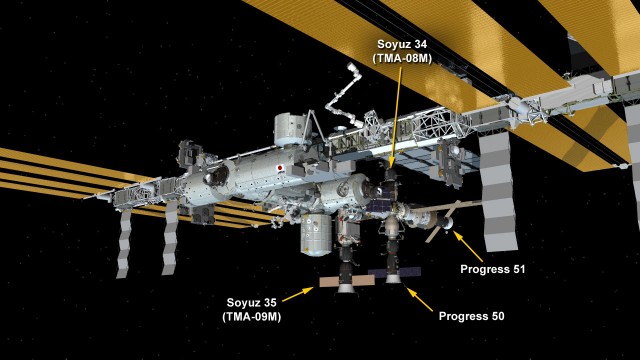 The International Space Station's configuration as of May 2013, showing the two docked Soyuz craft in which the crew would shelter in case of an emergency. Also called out are the two Progress resupply vehicles.
The International Space Station's configuration as of May 2013, showing the two docked Soyuz craft in which the crew would shelter in case of an emergency. Also called out are the two Progress resupply vehicles.
In fact, the pre-planned PDAM maneuver was developed and implemented in response to the last shelter event in the summer of 2011. NASA received a late notification about a potential conjunction and it had no choice but to have the crew enter the Soyuz craft; the debris ended up missing the ISS by about 725 meters. The hope now is that the PDAM will mitigate the need to shelter in the Soyuz from here on.
Day to day
When not actively figuring out where the station should be moving itself to avoid chunks of Chinese satellites or perhaps an errant Fourth of July firework, TOPO stays busy with a myriad of other tasks. "If we're not tracking any debris—and I don't believe we are right now—we have a set of tasks we do every day of the week. I mentioned that we maintain the knowledge of where the ISS is, so we work with the different flight control centers, specifically the flight dynamics facility at Goddard." TOPO, explained Parris, keeps Goddard up to date on the ISS' position in orbit so that the various NASATDRSS stations can keep their antennas pointed at it.
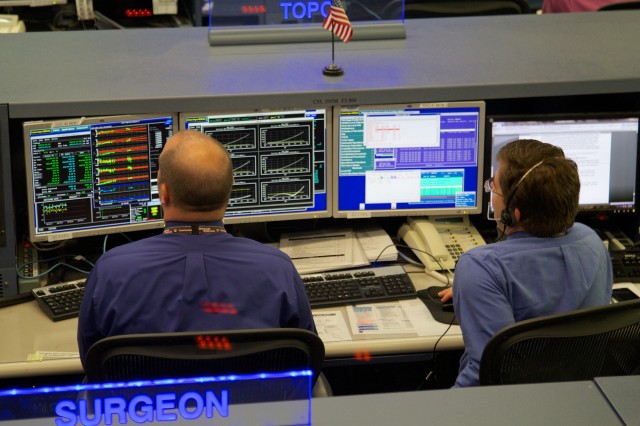
Parris at the TOPO console.
Unless they're actively planning a debris avoidance maneuver, TOPO's role is relatively passive and consists mostly of monitoring. At the TOPO console, Parris and the other TOPO controllers who man the station work off of three primary screens. "The first monitor is our ground GPS. The display on our very left—with the three columns—is the comparison of our ground data versus the on-board telemetry," which TOPO uses to compare where the ISS thinks it is versus where the ground tracking stations think it is. The middle screen also tracks the station's position. "The different charts show the delta between the different sources on-board versus our ground model. They're typically in a straight line."
On the right of the middle screen, behind the comparison charts, is a "situational awareness" monitor that shows the status of the various pieces of station hardware that TOPO uses. The right-hand screen contains the software NASA uses to maintain the ground ephemeris. "The top display is a list of vectors we have of the station, and the bottom display is the actual catalog of all the ephemerides we have for the station." Parris also pointed out that if TOPO were in the middle of a conjunction operation, the displays would show a totally different set of applications. The controller consoles are commodity hardware—PCs running Linux (there are also Windows 7 PCs employed in the flight control room, but the main controller displays are all Linux-powered). This type of flexibility is a far cry from the old days, when each flight controller's station was hard-wired and reconfiguration took hours or days.
Finishing up
The ISS mission control room is on the second floor of JSC's Building 30, and it actually occupies space that was once used for one of the two Apollo Mission Operations Control Rooms (the other room, on the third floor, has been restored to close to its Apollo-era configuration and can be seen by the public as part of the Space Center Houston tour). I was able to spend several more minutes snapping pictures; a couple of other flight controllers noticed me in the gallery and stuck their heads in to say "Hi," including William Foster, who mans the Ground Control console. While I snapped away, Parris resumed his place at the TOPO console, monitoring the station as it zoomed through space and keeping a watchful eye out for collisions. It's a job that never ends—and one that requires constant vigilance.
No comments:
Post a Comment
Let us know your Thoughts and ideas!
Your comment will be deleted if you
Spam , Adv. Or use of bad language!
Try not to! And thank for visiting and for the comment
Keep visiting and spread and share our post !!
Sharing is a kind way of caring!! Thanks again!